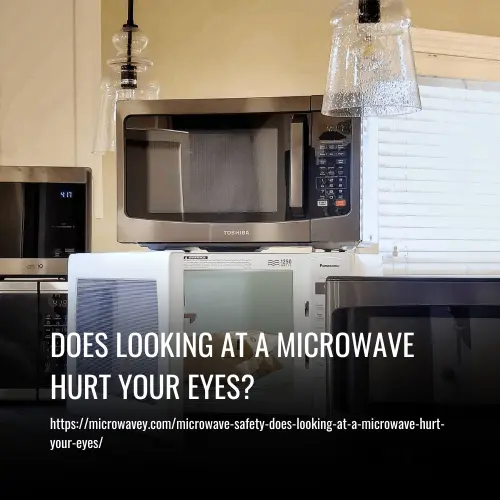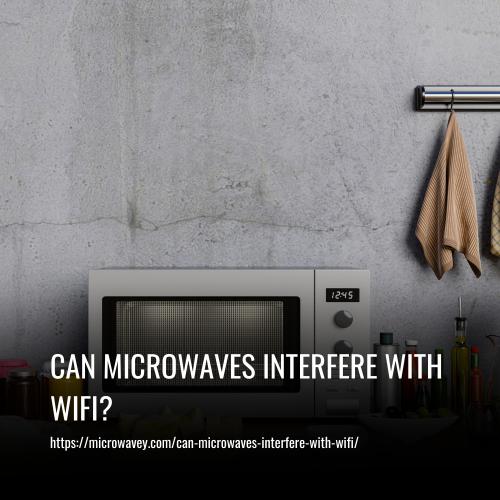Microwave Safety: Does Looking at a Microwave Hurt Your Eyes?
Looking at a microwave oven is not going to hurt a person’s eyes. Microwave ovens are built to contain most of the microwaves they emit and the waves that do get through are few and far between. A person’s eyes can be damaged by microwaves, but microwave ovens don’t emit enough to worry.
You really don’t need to worry much about looking at a regular microwave, but there are still some things you should do to be safe. Keep reading to learn more.

How Do Microwaves Hurt Your Eyes?
Microwave ovens are not very dangerous, but microwave radiation can be harmful.
Microwaves are electromagnetic waves similar to light, x-rays, infrared waves, and radio waves. These waves are actually all the same kind of radiation just at different wavelengths and frequencies. Microwaves are used for heating food, cell phone communication, and Radar.
Microwaves cause water molecules and other polar molecules like fat to spin back and forth at a molecular level. In a microwave oven, this causes the food (which usually has lots of water or fat in it) to heat up. This can also happen to people though. The human body is composed of lots of water and polar molecules.
When people come into contact with high levels of microwave radiation it will start to heat them up as well. The two spots on humans that will heat up the fastest are the eyes and the testes. These two spots have very little blood flow so they don’t regulate heat as well.
In your eye, the lens is the easiest structure to damage. High doses of radiation can lead to developing cataracts later cataracts are when the lens becomes cloudy and stiff. Cataracts need to be surgically removed and replaced with an artificial lens to restore vision.
This damage does not happen instantly and will usually develop only after exposure at high levels or over a considerable amount of time.

What Safety Features Do Microwaves Have?
Microwave Ovens are not going to hurt your eyes just from you looking at them.
Microwave Ovens were invented after a scientist during World War II discovered that the microwaves they were using to track airplanes had melted his candy bar. It took a while for them to catch on because of how big and expensive the first ovens were, but today almost everyone in the US has a Microwave oven in their house.
Since Microwaves are so popular the FDA in America has created safety regulations that force manufacturers to make ovens that prevent harm to the user. Modern microwave ovens use a technology known as a faraday cage to keep the radiation from leaking out.
A Faraday cage is made of conductive material and prevents microwaves from escaping. You can actually see the faraday shield on the windows of the microwave. The mesh on the windows of microwaves isn’t just for looks, they actually have holes so small that the microwaves can’t escape, but visible light can. This makes it so that you can see the food without microwaves getting to your eyes. Because of the shield, it is perfectly safe to see if your instant oatmeal is boiling over or not.
Microwaves also have a mechanism in place so that they will stop emitting microwaves if the door is opened. Unless this system is broken, microwaves shouldn’t work with the door opened.
Microwave ovens do leak some microwave radiation, but the FDA standards only allow for a small amount that isn’t enough to harm a person.

Tips to Stay Safe
There are a few safety precautions recommended by the FDA that you should take into consideration when using a microwave oven to cook your food.
- Make sure your microwave is not damaged before using it. You should be checking the door, hinges, seals, and latch to make sure they are not cracked, bent, or loose. If a microwave does show signs of damage it is possible that it may be leaking microwaves and you should replace it.
- If the microwave doesn’t turn stop when you open the door, you shouldn’t use that microwave anymore.
- Don’t stand right next to the microwave while it is running for long periods of time. This isn’t likely to cause any problems, but if your microwave does leak more than the recommended amount by accident this would help you not to have problems.
- Don’t clean the oven with steel wool or other abrasive cleaning implements that could damage the inside lining.
Other Safety Considerations
The large majority of Microwave oven-related injuries aren’t related to microwave radiation at all. The majority of injuries are burns from cooking things for too long, spilling hot liquids, and not using microwave-safe containers.
Always use containers, plates, bowls, and mugs that are marked as microwave-safe when heating up food. Some plates can become damaged or heat up excessively burning your hand when you go to take it out.
Don’t leave metal in the microwave.
Another phenomenon that could seriously hurt your eyes is superheating water. This is very rare, but if you heat water in a microwave it is possible to heat it past its boiling point if you heat it in a very smooth container. It is especially dangerous when the water has nothing mixed in with it.
When you superheat water you can often remove it from the microwave and put it on the counter and nothing will happen, but as soon as you drop some coffee mix, a tea bag, a spoon, or even just your finger to test the temperature the water will boil instantly and violently explode upward. This can easily burn your hands and face and is very dangerous. This doesn’t mean you can’t heat water in the microwave though, just make sure not to do it for too long. If you want to be extra precautions you can always mix your drink first.
FAQs
No, looking at a microwave while it is in use does not pose a risk to your eyes. Microwaves emit non-ionizing radiation, which means they do not have enough energy to damage the cells in your body, including your eyes.
Yes, it is safe to stand close to a microwave while it’s on. The design of the appliance prevents the microwaves from escaping the cooking chamber, so you are not at risk of exposure to harmful levels of radiation.
There is no evidence to suggest that prolonged exposure to microwave radiation from a properly functioning microwave can cause eye damage.
There is no need to wear protective gear when using a microwave. As long as the microwave is in good working condition and you follow the manufacturer’s instructions, there is no risk to your eyes or body.
There is no scientific evidence to support the claim that a microwave can cause cataracts or other eye problems.
To ensure safety when using a microwave, always follow the manufacturer’s instructions, avoid tampering with the appliance, and never operate it with the door open.
Conclusion
In conclusion, looking at a microwave won’t harm your eyes, so feel free to keep an eye on your delicious leftovers as they heat up. Remember, microwaves emit non-ionizing radiation, which is considered safe for human exposure in low levels. So go ahead, heat up your popcorn and enjoy your meal without any worries about your eyes!

